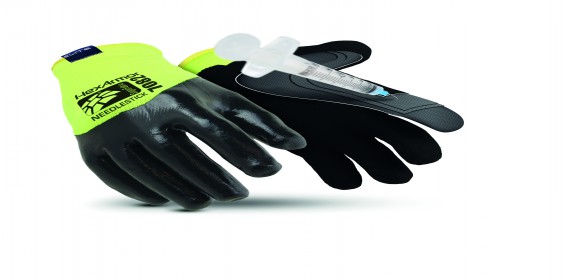Preventing needless injuries
Published: 18 October, 2019
There are an estimated 100,000 needlestick or sharps injuries in the UK every year, with many more taking place but not being reported. Cuts and lacerations from blades, saws, materials or machinery are also one of the most common workplace injuries and inadequate hand protection can be a factor in many of these accidents. PWE reports.
Most needlestick injuries arise in healthcare, but also frequently occur in the police and prison services, road, rail, air and sea transport and are particularly associated with cleaning operations, waste and recycling, utilities, local authorities (refuge, parks and housing), agriculture and private housing management companies.
These injuries can have a devastating effect on both the individual and their families, in terms of stress, worry, physical and mental health. Any number of harmful substances can be transmitted via cuts, punctures or needlestick injuries, from chemicals, to biological agents found in medical waste, to diseases such as hepatitis B and C and HIV/AIDS.
In the industrial sector, where many cuts begin with a puncture, existing cut-protective technologies tend to perform relatively well from a horizontal slash risk perspective, but offer limited protection against a sharp puncture from a piece of metal, plastic or wood.
The average hand injury can cost a company between £10,000 and £13,000. Add this to the economic effect of such injuries on businesses, including working days lost and unhappy employees, plus the risk of prosecution by the HSE, and it’s clear that needlestick and other cut and puncture injuries must be avoided at all costs.
Legislation
There are several pieces of UK legislation relevant to such injuries that demonstrate their seriousness, including:
• The Health and Safety at Work Act 1974;
• The Control of Substances Hazardous to Health Regulations (COSHH) 2002;
• The Management of Health and Safety Regulations 1999;
• The Reporting of Injuries, Diseases and Dangerous Occurrences Regulations 1995 (RIDDOR); and
• The Health and Safety (Sharp Instruments in Healthcare) Regulations 2013.
New EU glove standard
The best way to protect employees is with the right safety glove, made from the right materials, ensuring the gloves conform to the latest testing standards.
Safety gloves in the UK are governed by EU standards with the latest one being EN388:2016. The key amendment to this standard was cut protection and how high cut gloves are tested - EN IS0 13997. The new standard delivers the most accurate testing and offers the glove specifier a more informed choice of protection according to their risk.
In some cases, even more rigorous standards are applied in the US for glove testing. An example is the American ANSI/ISEA 105 standard for measuring cut protection, whilst in the EU we have no test procedure for needlestick performance and the only reference point for this is the ANSI ASTM-F2878 needle puncture test.
Both the EU and US now use similar testing methods for cut performance and the same test apparatus. However, the American standard has 3 higher levels (7-9) than in the EU, equating to 50% more cut protection versus the EU maximum test (F)
The amended European standard for cut protection gloves EN 388:2016 came into force on 21 April 2019, meaning that all new gloves must now be tested to this standard.
However, Industry leading manufacturers such as HexArmor have also been voluntarily testing existing gloves to the new standard for well over a year before it came into force and this results in slightly different markings on the glove to identify the new standard. An example of this is 4X34E as opposed to the old 4534.
Despite this, many employers and employees may not yet be aware of the change to this standard, which transpired following the development of new, high-performance fibres to guard against cuts, and offers a new, higher level cut-resistance rating from A to F rather than the previous one to five. Those who are unaware may still be suffering cut injuries unnecessarily.
Technological advances
The development of these new materials has already had a huge effect, offering far higher levels of protection than ever before.
With the test method enhancing, traditional cut protection technologies have also improved in their performance, but they still do not offer protection from cuts caused by punctures, owing to their knitted design, which allows easy penetration. What is needed is a material that deflects a sharp point away from the hand, fingers, wrist or body.
One material that is claimed to offer such protection – SuperFabric (exclusively used by HexArmor gloves), contains tiny guard plates bonded on to the fabric that prevent puncture by blocking or deflecting a sharp point, blade, metal splinter or part of machinery, while remaining breathable and lightweight. HexArmor says that SuperFabric provides between four to six times the cut protection and double the needlestick protection compared to traditional materials on the market.
The fabric also works against abrasion with no loss of dexterity and does not degrade over time – another big advantage.
In addition, HexArmor comments that gloves with SuperFabric offer a much higher rate of cut, puncture and needlestick resistance than the current European standard in all areas, in both tests and in real life. So using these extremely effective, high-performance gloves is surely a no-brainer to avoid the misery of these easily-preventable injuries.







